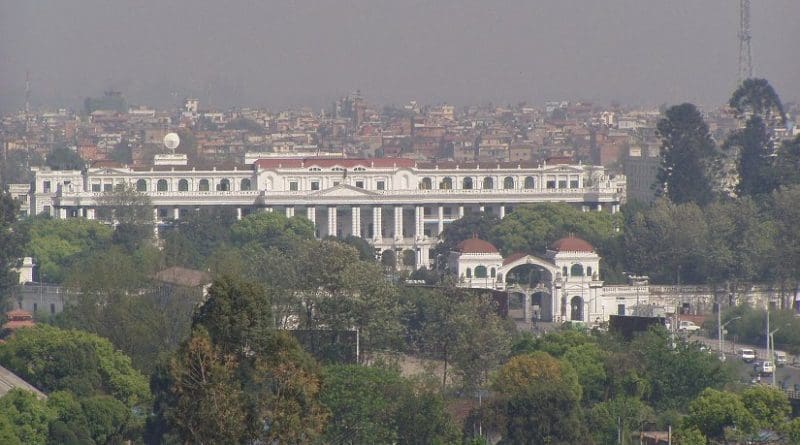India Don’t Allow China To Become Your Alternative In Nepal – OpEd
By Dr. Binodkumar Singh*
Nepal, a land-locked country bordered by India on the south, east and west, and China on the north, is dependent on its neighbors for transit and supplies. Overwhelmingly, Nepal is reliant upon imports from India. About 60% of the total imports including much of its food, consumer goods and 100 percent of its fuel – aviation fuel, petrol, diesel and cooking gas are from India. Currently, the trade between Nepal and India hovers at around $5 billion per annum.
However, the border blockade by the United Democratic Madhesis Front (UDMF) comprising of the Upendra Yadav-led Federal Socialist Forum-Nepal (FSF-N), the Mahantha Thakur-led Tarai Madhes Democratic Party (TMDP), the Rajendra Mahato-led Sadbhawana Party (SP) and the Mahendra Raya Yadav-led Tarai Madhes Sadbhawana Party (TMSP) which began on September 23, 2015 and called off on January 8, 2016, in protest against Nepal’s new Constitution was an economic and humanitarian crisis severely affecting Nepal and its economy. As perceived as an undeclared blockade that India has imposed at its border points, the blockade has indeed dealt a massive blow to Nepal’s relationship with India.
Worryingly, Federal Alliance, an Alliance of UDMF constituents and four other Madhesi parties Sharat Singh Bhandari-led National Madhes Socialist Party (NMSP), Anil Kumar Jha-led Nepal Sadbhawana Party (NSP), Rajkishor Yadav-led Madhesi Janadhikar ForumRepublican (MJF-R) and Kaushal Kumar Singh-led Lok Dal (LD) on March 21, 2016, urged the public to prepare for a decisive joint people’s movement. The Alliance said that it would continue to fight for identity-based federalism no matter how difficult and how long the battle was.
Amid fears of a repeat of the recent crippling blockade throwing normal life out of gear, on March 20, 2016, Prime Minister KP Sharma Oli reached Beijing for a week-long official visit at the invitation of his Chinese counterpart Li Keqiang. On March 21, 2016, Nepal and China sealed 10 separate agreements and Memorandums of Understanding including using China’s sea port facility, building a regional international airport in Pokhara and exploring the possibilities of signing a bilateral free trade agreement and finding oil and gas reserves in Nepal.
Earlier at the height of the political crisis over the new Constitution, as critical supplies from India were choked off by the blockade, Nepal turned to China and signed a memorandum of understanding with the China National United Oil Corporation on October 28, 2015. Further, on December 24, 2015, China and Nepal pledged to expand cooperation in key sectors as Nepalese Deputy Prime Minister Kamal Thapa kicked off a five-day visit to the country, the first high-level visit from Nepal. China opened its border point with Nepal in Tibet for supplying fuel and essential commodities. For China, Nepal is strategically important as it shares sensitive Tibet borders. Moreover, wary of dissent among Tibetan exiles living in Nepal, Beijing has been building up close ties with Kathmandu. Underscoring its growing presence, China overtook India as the biggest source of Foreign Direct Investment (FDI) in Nepal in 2014.
However, it is also a fact that China cannot completely replace India as far as Nepal’s trade and transit is concerned. Geographically too, it would require mammoth investments from both sides for Nepal to enjoy trade and transit facilities from China in par with India. For example, to gain advantage from the agreement on transit transport signed between Nepal and China, Nepal first needs to find a Chinese port that is viable for third-country trade. Nepal may not be able to reap maximum benefit from the deal unless China’s railway link is extended to Nepal’s border point. This is because ferrying goods via road through Tibet may not always be cost-effective and convenient. Moreover, China will think of India before making any move in Nepal because China is India’s biggest trade partner. It won’t jeopardize this business relation for the small Himalayan nation that has nothing to offer to China.
No doubt, common sense dictates to carry on Nepal’s relationship with India as the Chinese mainland is far away. However, in the long term, it signifies that China will replace India as the main supplier of commodities as Beijing has planned the construction of a railway line connecting Shigatse with Kyirong county and Nepal’s border during the 13th Five-Year Plan (2016-2020). Whereas the problem with Delhi is that it is often seen as a country which reacts rather than take any initiative to act. It is not the case with Beijing.
Indeed Nepal’s China tilt has never been this pronounced and it’s entirely the result of New Delhi’s policy. Certainly, it will take time to diversify Nepal’s supply sources. Nepal’s situation vis-à-vis India means Nepal will not overnight convert itself into a pro-China holdout. But this still is a significant shift in South Asian geopolitics. As the recent border blockade has proved, Nepal can no longer rely on its traditional trading partner India to help itself move toward the path to economic prosperity. And, Nepal has to enjoy the benefit in real and measureable terms of being locked by the two economic giants of the twenty-first century as Prime Minister KP Oli on the third day of his China visit on March 22, 2016, rightly said “We can use ports in both India and China for transit and as a sovereign country we can sign a deal with India and China as well.”
*Dr. Binodkumar Singh is a Research Associate, Institute for Conflict Management, New Delhi. He can be reached at: [email protected]

